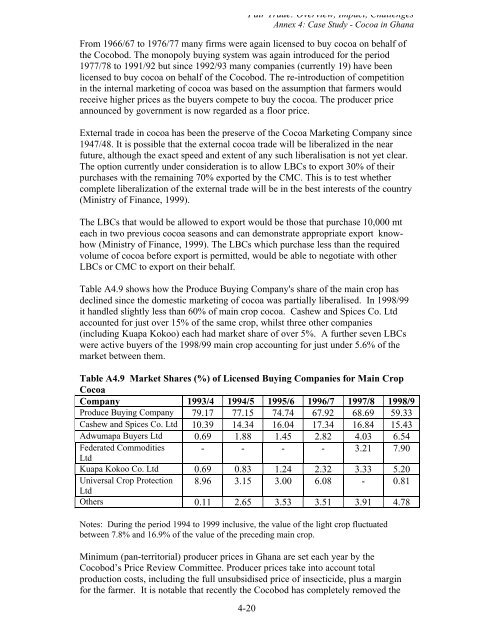Fair Trade: Overview, Impact, Challenges - Are you looking for one ...
Fair Trade: Overview, Impact, Challenges - Are you looking for one ...
Fair Trade: Overview, Impact, Challenges - Are you looking for one ...
You also want an ePaper? Increase the reach of your titles
YUMPU automatically turns print PDFs into web optimized ePapers that Google loves.
<strong>Fair</strong> <strong>Trade</strong>: <strong>Overview</strong>, <strong>Impact</strong>, <strong>Challenges</strong><br />
Annex 4: Case Study - Cocoa in Ghana<br />
From 1966/67 to 1976/77 many firms were again licensed to buy cocoa on behalf of<br />
the Cocobod. The monopoly buying system was again introduced <strong>for</strong> the period<br />
1977/78 to 1991/92 but since 1992/93 many companies (currently 19) have been<br />
licensed to buy cocoa on behalf of the Cocobod. The re-introduction of competition<br />
in the internal marketing of cocoa was based on the assumption that farmers would<br />
receive higher prices as the buyers compete to buy the cocoa. The producer price<br />
announced by government is now regarded as a floor price.<br />
External trade in cocoa has been the preserve of the Cocoa Marketing Company since<br />
1947/48. It is possible that the external cocoa trade will be liberalized in the near<br />
future, although the exact speed and extent of any such liberalisation is not yet clear.<br />
The option currently under consideration is to allow LBCs to export 30% of their<br />
purchases with the remaining 70% exported by the CMC. This is to test whether<br />
complete liberalization of the external trade will be in the best interests of the country<br />
(Ministry of Finance, 1999).<br />
The LBCs that would be allowed to export would be those that purchase 10,000 mt<br />
each in two previous cocoa seasons and can demonstrate appropriate export knowhow<br />
(Ministry of Finance, 1999). The LBCs which purchase less than the required<br />
volume of cocoa be<strong>for</strong>e export is permitted, would be able to negotiate with other<br />
LBCs or CMC to export on their behalf.<br />
Table A4.9 shows how the Produce Buying Company's share of the main crop has<br />
declined since the domestic marketing of cocoa was partially liberalised. In 1998/99<br />
it handled slightly less than 60% of main crop cocoa. Cashew and Spices Co. Ltd<br />
accounted <strong>for</strong> just over 15% of the same crop, whilst three other companies<br />
(including Kuapa Kokoo) each had market share of over 5%. A further seven LBCs<br />
were active buyers of the 1998/99 main crop accounting <strong>for</strong> just under 5.6% of the<br />
market between them.<br />
Table A4.9 Market Shares (%) of Licensed Buying Companies <strong>for</strong> Main Crop<br />
Cocoa<br />
Company 1993/4 1994/5 1995/6 1996/7 1997/8 1998/9<br />
Produce Buying Company 79.17 77.15 74.74 67.92 68.69 59.33<br />
Cashew and Spices Co. Ltd 10.39 14.34 16.04 17.34 16.84 15.43<br />
Adwumapa Buyers Ltd 0.69 1.88 1.45 2.82 4.03 6.54<br />
Federated Commodities<br />
Ltd<br />
- - - - 3.21 7.90<br />
Kuapa Kokoo Co. Ltd 0.69 0.83 1.24 2.32 3.33 5.20<br />
Universal Crop Protection<br />
Ltd<br />
8.96 3.15 3.00 6.08 - 0.81<br />
Others 0.11 2.65 3.53 3.51 3.91 4.78<br />
Notes: During the period 1994 to 1999 inclusive, the value of the light crop fluctuated<br />
between 7.8% and 16.9% of the value of the preceding main crop.<br />
Minimum (pan-territorial) producer prices in Ghana are set each year by the<br />
Cocobod’s Price Review Committee. Producer prices take into account total<br />
production costs, including the full unsubsidised price of insecticide, plus a margin<br />
<strong>for</strong> the farmer. It is notable that recently the Cocobod has completely removed the<br />
4-20
















![CynefinFramework final [Read-Only]](https://img.yumpu.com/19017304/1/190x135/cynefinframework-final-read-only.jpg?quality=85)